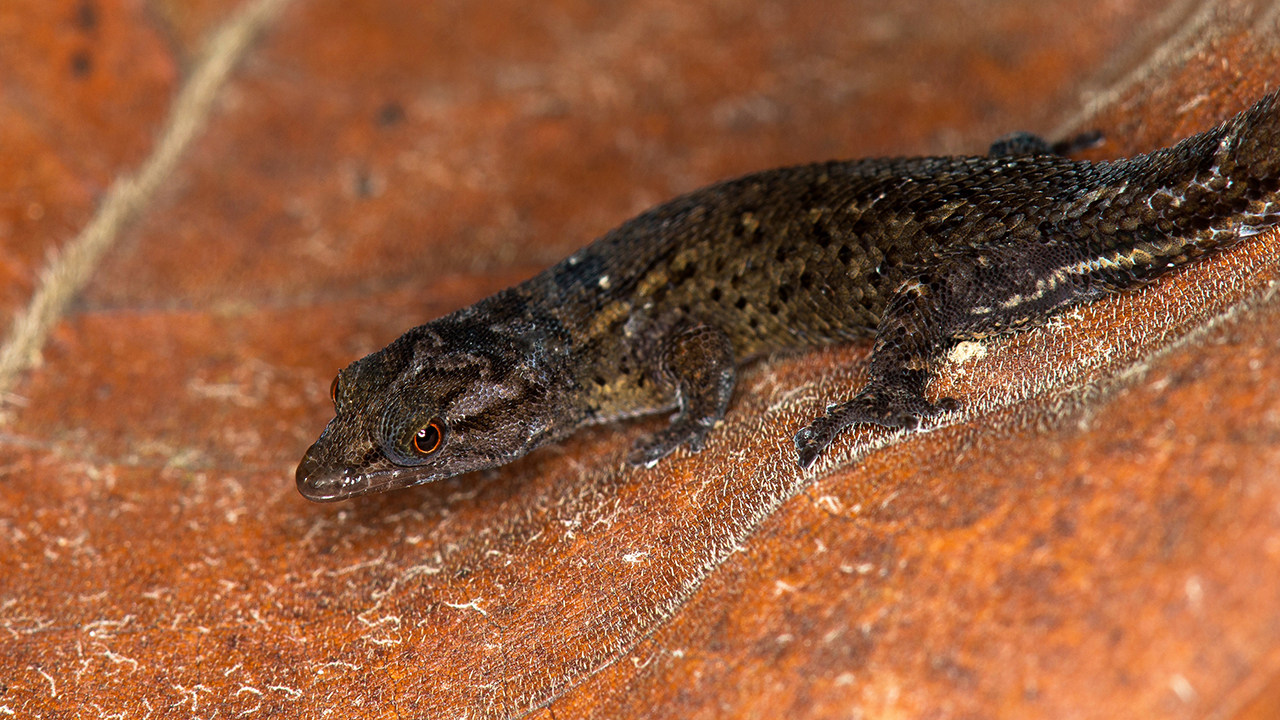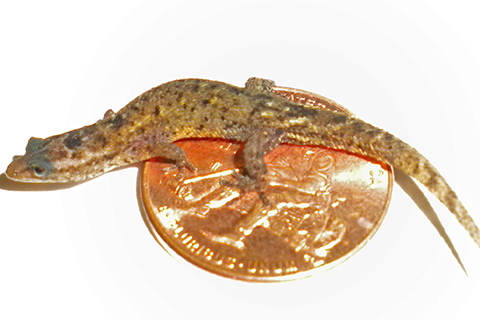OU professor helps discover, describe new species of gecko in Puerto Rico

Up to this week, there have been six previously recognized species of geckolettes (or dwarf geckos, genus Sphaerodactylus), endemic to Puerto Rico. However, this number has just been updated.
On August 23, the Journal of Ichthyology and Herpetology published a description of a brand-new species, the karst gecko (Sphaerodactylus verdeluzicola). The team of researchers that contributed to this study was led by Dr. Alondra Díaz-Lameiro from the University of Puerto Rico, and included her longtime collaborator, Dr. Taras K Oleksyk, an assistant professor in the Department of Biological Sciences at Oakland University.
 |
The West Indies are a unique living evolutionary laboratory where islands are positioned close to each other, allowing species to move from island to island. Yet, these islands are also sufficiently isolated to result in and support endemic animals and plants. The diversity of species on the Caribbean islands is mostly a result of colonization events by overwater dispersal followed by isolation and adaptation to the local insular conditions.
This is true for the geckolettes from the Caribbean, Central America, and South America. These lizards are tiny (20–35 mm) and hard to see — normally hiding in leaf litter, under rocks, logs, or even trash. They have important advantages over other potential colonists that allowed them to become pioneers in the new lands; for example, they have eggs that are resistant to the effects of dehydration and temporary immersion in sea water.
Geckolettes diversified after the initial colonization of the West Indies during the period of low sea levels at the start of the Oligocene Epoch (38–22 million years ago), which meant an increased connectivity of the islands to South America. Today, it is believed that almost every island has developed a specific group of geckolettes that gradually inhabited the dry forests.
For some time, scientists have suspected that the number of species described in Puerto Rico is incomplete, but did not have sufficient tools to revise it. However, with recent advances in DNA sequencing and bioinformatic analysis, it became possible to see beyond what meets the eye. Researchers figured out how to use the molecular sequence data to make out how and when the animals arrived at their current habitats, when the different species originated, and which migration routes they took crossing the sea from island to island.
In their first paper almost 10 years ago, Díaz-Lameiro and Oleksyk used mitochondrial DNA sequences to reconstruct the evolutionary history of the colonization of Puerto Rico, and the smaller islands of Mona, Monito and Desecheo to the west, in the Mona Passage that connects the Atlantic to the Caribbean Sea. While Mona and Monito are directly adjacent to each other, they have two different species of geckolettes. The island of Desecheo is 30 miles from Mona and Mona 40 miles from the main island of Puerto Rico. It turns out that the Desecheo gecko (S. levinsi) is most closely related to the Mona gecko (S. monensis) then they were to the other six species. This supported the hypothesis that these species dispersed overwater in the direction of the sea currents.
The first geckos arrived to the main island of Puerto Rico approximately 11 million years ago, then they colonized Mona from the south of island approximately 3 million years ago and arrived to the Desecheo island from Mona approximately 2.6 million years ago. Meanwhile, on the main island, the diversification continued as the tiny lizards adapted to diverse habitats there resulting in seven species of geckoes, one of which was unknown until now.
When Díaz-Lameiro and Oleksyk, with other coauthors, wrote a paper in 2013 examining molecular sequence data, they also reported the existence of a distinct lineage of geckolette from the northwestern karstic areas of Puerto Rico. Sequences from these animals, collected in the municipality of Rincón, consistently formed an exclusive evolutionary lineage and was morphologically distinct from other described species. Later, another paper reported a similar result but from the northern part of the island, around Bosque Estatal de Río Abajo. This was molecular evidence for existence of new, never before discovered species of lizard.
However, to formally recognize a new species, a special report needed to be published that would reconcile all the previous knowledge, combine morphological and genetic data to demonstrate the differences with the other species, and officially announce a new species. The new paper, published in Ichthyology and Herpetology, is the first description of a new species of geckolette from Puerto Rico in nearly a century, highlighting the need to study biological diversity even in well-studied regions.
“We live in an extraordinary time,” Oleksyk said. “Many living species around us disappear quickly, sometimes even before they are found and described. When they go, we lose a piece of puzzle that is life on Earth. Each time a species goes extinct, the world we used to have around us unravels, and there is no way to get back what is lost, or to understand what happened. This is why we must document the diversity of life as much as is still possible, before another species has perished. The more species we know, the better we can understand how to preserve the wonderful diversity of life on our planet.”
The common name of this new species, the karst gecko — Latin name, Sphaerodactylus verdeluzicola — is a dedication to an old Puerto Rican song, “Verde Luz,” written by Antonio Cabán Vale from Moca in Western Puerto Rico. Also, the beach at Rincón, where the species was first discovered, is a famous spot to watch the “green flash” finale of a beautiful sunset over the waters of Mona Passage. This optical phenomenon occurs at dusk at the moment when the sun dips below the horizon over the water, and the light is being dispersed through the Earth's atmosphere like a prism, causing a sudden change to bright green. It is said that once you've seen a “green flash,” you will never again go wrong in matters of the heart.
“Most Puerto Ricans not only know the song but can sing the lyrics by heart,” Diaz-Lameiro said. “It's commonly used in commercials, baseball games, and public events. It's also taught in schools, and some consider it a second national anthem.”
The song's first verse describes natural wonders of the island, which happen to correlate to the gecko’s habitat. Beginning and ending with the phrase ‘Verde luz de monte y mar’ (green light from mountains and sea), which refers poetically to the beauty of the mountain and the sea in Puerto Rico. The name is meant to be allegorical referring to the places where the geckolette was found: hiding in the thick litter, found only in a beach in Rincon, and the karst mountains of Rio Abajo.
In addition to this research study, Oleksyk and Díaz-Lameiro have collaborated on several projects and published other papers on animals from the Caribbean, including a study on Puerto Rican paso fino horses in 2022 and a study on Puerto Rican parrots in 2019.


 August 23, 2022
August 23, 2022